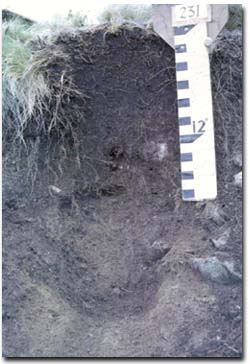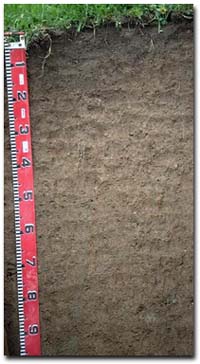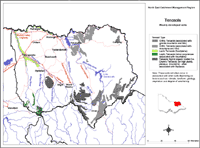Tenosols
Tenosols have only weak soil profile development and are often shallow. In the Australian Soil Classification they are defined as having limited subsoil (B horizon) development (less than 15% clay content). However, Tenosols have more development than the most rudimentary soils i.e. Rudosols as they include bleached layers and colour changes. Using the Australian Soil Classification, Tenosols can be subdivided according to surface organic matter depth and percentage, bleached layers, development of a subsoil and contact with material immediately below.
Note that other soil types may also occur within these mapped areas either dominantly or sub-dominantly, depending on factors such as climate, landform, geology, vegetation and degree of weathering. This map will continue to be updated as new information becomes available. Access the Soil and Land Survey Directory from this website to find out about more detailed information from various soil and land surveys that cover parts of this region. |
These soils tend to develop on rocky areas in the uplands or on alluvial or aeolian (wind blown) deposits where soil development is weak.
The main Tenosol groups recognised in the North East region are:
- Chernic Tenosols
- Orthic Tenosols
- Leptic Tenosols
Chernic Tenosols have a well-developed organic A horizon (peaty, humose, melacic or melanic) which is more than 20 cm thick overlying a weakly developed subsoil horizon or a transitional subsoil/weathered rock horizon occurring in fissures in the parent rock or saprolite.
Chernic Tenosols are the most common soils of the sub-alpine and alpine high plains and broad mountain ridges. In North East Victoria they have usually been known as alpine humus or organic loam soils. They are typically strongly acid with pH's as low as 3.8 and are characterised by low plant-nutrient status, except for the upper few centimetres. There is much evidence that many of the Chernic Tenosols on the high plains have formed on remnants of earlier soils (pedoderms) (Brewer et al. 1970). These can have weakly developed B horizons that are separated from the A horizon by a stone line. This indicates an old erosion surface.
Orthic Tenosols
These soils occur on the younger parts of the landscape in lower rainfall areas. They are formed on the steep hills in the north and in the rain shadow area around Omeo. They are more prevalent on the drier north and northwest aspects. These soils often merge with Kandosols as the clay content can be slightly higher than specified as the upper limit for Tenosols (i.e. 15%).
Leptic Tenosols
Previously, these soils have been referred to as meadow soils and prairie soils (Rowe 1967) as well as brown and grey loam soils (Rowe 1984). Leptic Tenosols occur on fine textured alluvium along the major streams. They have well structured, organic matter darkened surface (A) horizons but no significant pedologic development at depth. They are moderately to strongly acid and are commonly underlain by a gravel bed at about one metre depth.
| Chernic Tenosols Previously referred to as:
Surface (A) horizons Thick organic rich A horizon, loam texture, strong fine granular structure, high porosity, extremely acid, gradual boundary change. C horizon Weathering rock e.g. granite. |  Chernic Tenosol - alpine humus soil. |
| Orthic Tenosols Previously referred to as:
Occurrence:
|  Orthic Tenosol developed on granite in the Tallangatta Valley. |
References
Rowe, R.K (1967). A Study of the Land in the Victorian Catchment of Lake Hume. Soil Conservation Authority. Victoria. Technical Communication 5.
Rowe, R.K (1984). A Study of the Land in the Catchments of the Upper Ovens and King Rivers. Soil Conservation Authority. Victoria. Technical Communication 16.
Rowe, R.K (1972). A Study of the Land in the Catchment of the Kiewa River. Soil Conservation Authority. Victoria. Technical Communication 8.



